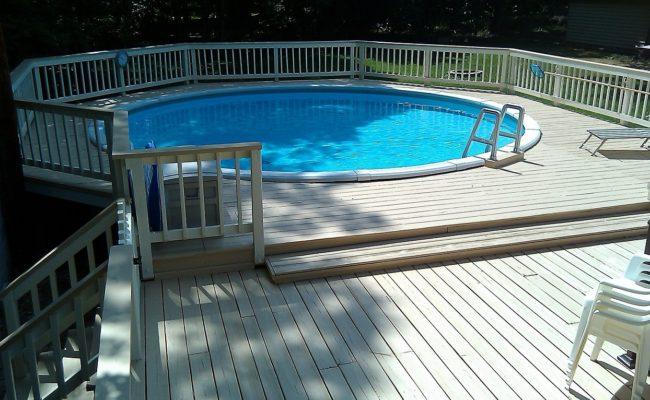Summer’s winding down, and if you’ve got an above ground or semi-inground pool, now’s the time to start thinking about closing things up. Whether this was your first season or your tenth, wrapping up the right way makes all the difference when next year rolls around.
If you are not sure where to start—we’ve got you covered with a simple, no-fuss end-of-season pool checklist that’ll help protect your pool all winter and make reopening way easier in the spring.
Let’s dive in.
1. Clean Everything—Really Well
This one sounds obvious, but it’s worth repeating: don’t close your pool dirty.
- Skim out leaves, bugs, and any other floating debris.
- Vacuum the pool floor to get rid of dirt or gunk that’s settled at the bottom.
- Scrub the walls and waterline to prevent build-up or stains.
- Empty out your skimmer and pump basket.
Starting with a clean pool means you won’t open it next year to cloudy or green water. It also helps protect your liner and keeps staining to a minimum.
2. Balance Your Water One Last Time
This step is huge for above ground and semi-inground pools. Before closing, get your water chemistry in check:
- pH: 7.4–7.6
- Alkalinity: 80–120 ppm
- Chlorine: 1–3 ppm
- Calcium hardness: 175–250 ppm
If those numbers don’t mean much to you, no problem—just bring a water sample to your local pool store and ask for a closing test. Balancing the water helps prevent corrosion, scaling, and algae growth while your pool’s covered.
3. Add Winterizing Chemicals
Once the water is balanced, you’ll want to add a winter chemical kit. These usually include:
- A long-lasting algaecide
- A pool shock (chlorine or non-chlorine-based)
- A stain and scale preventer
These chemicals help keep the water clear and sanitary through the off-season. Just be sure to follow the instructions carefully—too much can cause issues, and too little won’t do the job.
4. Lower the Water Level (If Needed)
Depending on your pool type and cover, you might need to lower the water level a few inches below the skimmer or return jet.
- For above ground pools: Lower just below the skimmer to avoid water getting into it and freezing.
- For semi-inground pools: Follow your manufacturer’s recommendation—it may vary based on how much of the pool is exposed.
If you’re using an air pillow (more on that next), lowering the water level helps prevent pressure on the pool walls when ice forms.
5. Use an Air Pillow (Especially for Above Ground Pools)
An air pillow goes under the winter cover and sits in the center of the pool. Its main job? To absorb pressure from expanding ice and help prevent damage to the pool walls and liner.
It also helps rain and snow run off the cover instead of pooling in the middle.
Pro tip: tie the pillow to the sides of your pool with string so it stays centered under the cover.
6. Remove and Store All Accessories
Before putting the cover on:
- Take out the ladder and any steps or rails.
- Disconnect and clean your pump and filter.
- Let everything dry completely before storing it in a shed, garage, or dry area.
Leaving accessories or equipment out all winter exposes them to freeze damage and wear—and trust us, replacing them isn’t cheap.
7. Cover It Up Right
Your pool cover does the heavy lifting all winter, so make sure it’s in good shape:
- Clean and inspect your winter cover for rips or weak spots.
- For above ground pools, use a cable and winch system to keep the cover tight.
- Add cover clips or water bags for extra security if you’re in a windy area.
Make sure the cover fits snugly and doesn’t sag too much in the middle—that’s how leaves and snow start piling up.
8. Double-Check Safety and Security
If you’ve got pets, kids, or just a lot of backyard traffic, double-check that your cover is secure and safe. You don’t want anyone accidentally stepping on it or trying to lift it mid-winter.
Now’s also a good time to check your fence or gate, especially if local laws require certain safety measures around your pool.
Need a Hand With Closing Your Pool?
If this checklist feels a little overwhelming—or if you just want peace of mind that everything’s done right—we’re here to help.
At Westrock Pools, our professional pool maintenance and closing services for above ground and semi-inground pools take the stress out of the end-of-season routine. We’ll handle water balance, equipment prep, chemical treatment, and cover installation—so you can head into fall knowing your pool is protected.

